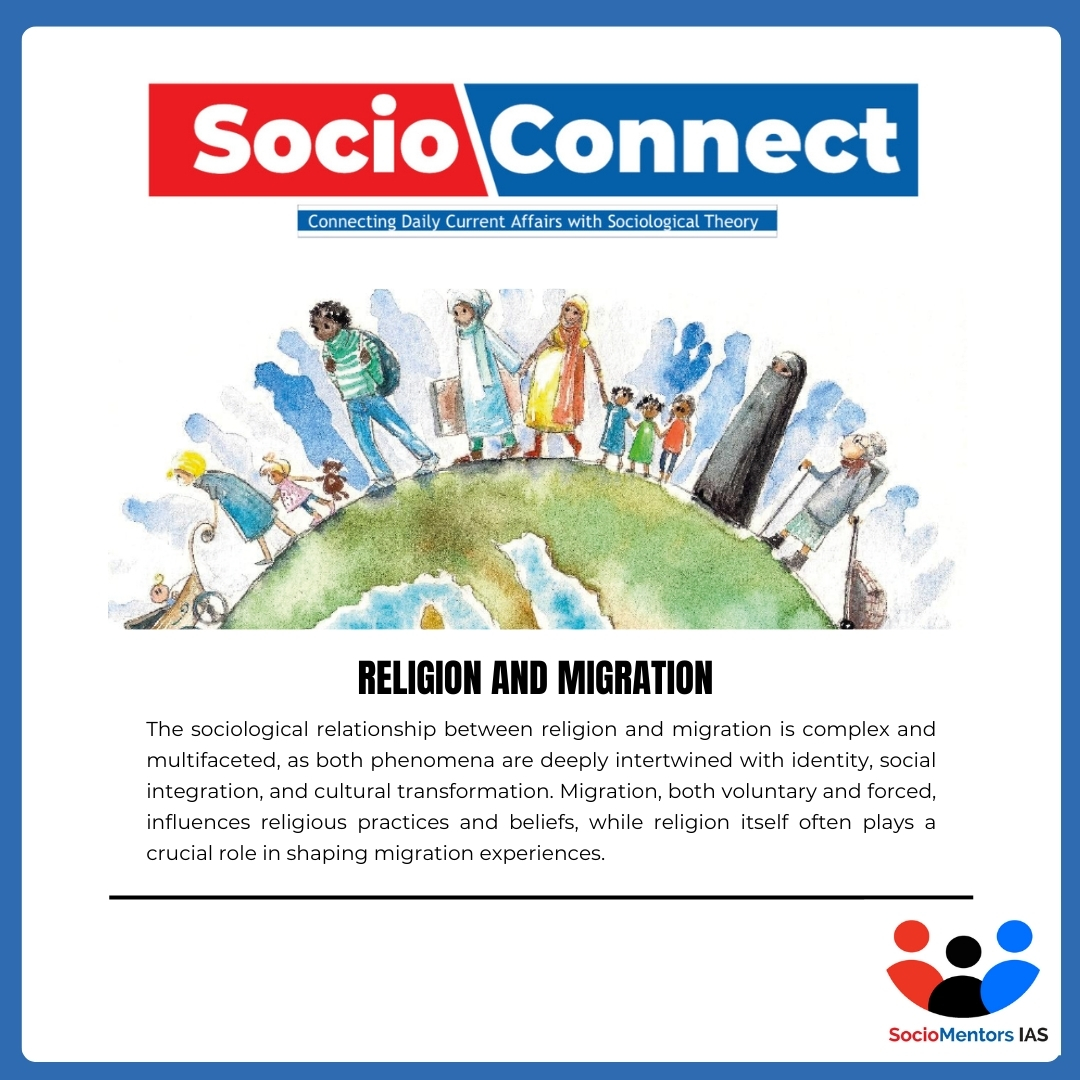Religion and Migration – UPSC Sociological Perspective
September 6, 2024
`A new report Faith on the Move published by Pew Research Center’s Forum on Religion & Public Life focuses on the religious affiliation of international migrants, examining patterns of migration among seven major groups: Christians, Muslims, Hindus, Buddhists, Jews, adherents of other religions and the religiously unaffiliated.
Key Findings of the Report
- Christians are the largest migrant group, accounting for 47% of all international migrants, despite making up 30% of the global population. Mexico is the most common origin country, with the U.S. as the top destination.
- Muslims make up 29% of migrants, slightly above their global population share of 25%. Syria is the largest source country, with Saudi Arabia as a frequent destination.
- Religiously unaffiliated migrants constitute 13% of the total, though globally they represent 23% of the population. China is the most common origin country, and the U.S. the top destination.
- Hindus (5%) and Buddhists (4%) are underrepresented among migrants relative to their global population shares of 15% and 4%, respectively.
- Jews are overrepresented among migrants, making up 1% of the migrant population despite being just 0.2% of the global population. Israel is both the main origin and destination for Jewish migrants.
- Jewish migration is the highest among all religions, with one in five Jews living outside their birth country.
Reasons for Migration on Religious Grounds
- Religious Persecution: People often migrate to flee religious persecution, especially in regions where minority religious groups face discrimination, violence, or restrictive government policies. For example, Rohingya, a Muslim minority in Myanmar, faced brutal persecution, leading to mass migration to neighbouring countries like Bangladesh.
- Seeking Religious Freedom: Migrants often move to countries where they can freely practice their faith without restrictions. This includes relocating to places with more liberal religious policies or where their faith is dominant. For example, Jews have historically migrated to countries offering greater religious freedom, such as Israel and the U.S.
- Religious Pilgrimages or Sacred Locations: Some people migrate or temporarily relocate to live near religiously significant locations or engage in long-term religious activities such as pilgrimages. For example, Muslims from various parts of the world move to Saudi Arabia for religious reasons, such as performing Hajj or Umrah, and some may settle there long-term. Hindu devotees may move to religious cities in India, like Varanasi, to live closer to sacred sites.
- Joining Religious Communities: Migrants may move to regions where their religious community is more established. This allows them to live among people who share their religious beliefs and cultural practices. Jewish migration to Israel is often motivated by the desire to live among fellow Jews.
- Escape from Religious Conflicts or Wars: Religious tensions or sectarian violence can lead to forced migration, where individuals or entire communities flee from conflict zones. The partition of India and Pakistan in 1947 caused massive religious-based migration between Hindus and Muslims across borders.
- Assimilation and Conversion: Migrants may also move to adopt or shed religious identities. For instance, individuals may migrate to convert to a new religion or distance themselves from their previous religious communities.
Issues Faced by Migrants in Host States on the basis of Religion:
- According to Bryan S. Turner, tension arises between secularization and religious pluralism in modern societies. In many host countries, migrants introduce new religious practices, leading to greater pluralism but also friction with the secular state. For example, France’s ban on religious symbols, including the hijab, in public schools has sparked controversy among Muslim migrants, raising issues of religious freedom versus the state’s secular ideals.
- Marginalization: Migrants may experience marginalization based on their religious identity, where dominant groups (either religious or secular) use their power to restrict migrants’ rights, opportunities, or access to resources. For example, in the United States, Muslim migrants have faced increasing levels of Islamophobia, particularly after 9/11. Policies such as the “Muslim ban” (executive order 13769) reflect how religion became a point of political contention, positioning Muslim migrants as “threats” to national security.
- Cultural Imperialism: The host society may impose secularism or religious dominance on migrant communities, reminiscent of colonial practices. Migrants’ religious practices are seen as “backward” or “inferior,” justifying their exclusion from the public sphere. The exclusion of Muslim migrants from Western political discourse on the grounds that their religious values conflict with “modern” or “secular” values reflects the legacy of colonial thought, where non-Western religions were often considered uncivilized.
- Intersectionality: Migrants who are part of both religious and racial minorities face double discrimination in host countries. This is particularly evident in the case of African Muslims in Europe, who face prejudice not only due to their religion but also due to their race and immigration status. For example, Somali Muslim migrants in Norway face discrimination that stems from both their religious identity and their status as African immigrants, making it harder to integrate into society. They encounter barriers in employment, education, and housing due to racialized religious stereotypes.
- Hate Crimes: Migrants may experience “labeling” based on their religious background, which can affect their self-identity and how they are perceived by others. This can lead to a form of “othering,” where migrants are seen as outsiders because of their religious affiliation. This often leads to religious migrants being targets of hate crimes, physical attacks, or verbal harassment in public spaces or religious sites. With the rise of social media, religious migrants may face cyberbullying or hate speech based on their faith. In India, Christians are sometimes targeted by radical Hindu groups. Incidents of violence, such as the Kandhamal riots in Odisha (2008), have led to internal displacement of Christian families. Anti-conversion laws in several Indian states have led to harassment and arrest of Christians who are accused of converting Hindus.
- Workplace Issues: Migrants often face challenges when requesting religious accommodations, such as time off for religious holidays, prayer breaks, or wearing religious attire (hijabs, turbans, etc.) in host countries.
Hostilities arise from deep-rooted social, cultural, and structural factors, including stereotypes, institutionalized discrimination, and societal inequalities. This relates to ethnocentrism, where the dominant group perceives its own culture as superior. Campaigns and curricula that highlight the diversity within religious groups and counter xenophobic rhetoric can challenge widespread misconceptions. Social integration policies must aim to create spaces where migrants are not viewed as the “Other” but as part of a pluralistic society.



